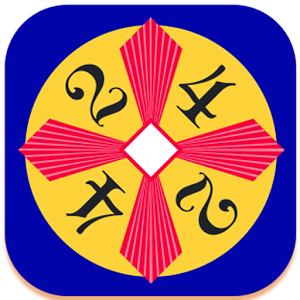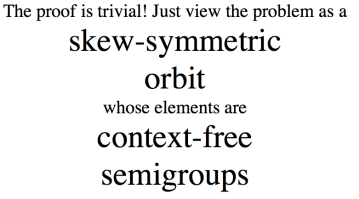Posts on with high probability focus on topics in combinatorics, probability, and theoretical computer science. Most are mathematically accessible to anyone who’s curious enough to read them!
The Hardest Games of 24
In elementary school, my class would play a game called 24. The teacher would hold up a card that had 4 numbers on it. Using each number on the card exactly once and only for operations, the goal was to make the number 24. And do it faster than all the other kids, obviously.

A couple days ago, one of my friends gave us a particularly good one. So I thought I’d share the 5 hardest 24 puzzles! Some other people have already gone through the trouble of figuring out which are the most difficult. Enjoy!
The Algebraic Analog of P vs NP
Mathematicians often isolate themselves within their specialties (the algebraic geometers vs the analysts vs the probabilists vs the theorists and so on). But some of the most brilliant results arise from applying tools from one field to problems in another.
One of the largest open problems in mathematics and computer science is the P vs NP problem. It asks whether a problem whose solution can be checked in polynomial time is actually solvable in polynomial time. You can learn the basics about P vs NP here. Since the problem was formalized by Stephen Cook in 1971, many people in complexity theory have spent their time trying to make progress on it. So why is P vs NP unsolved? Fundamentally, some people think that the problem cannot be proved or disproved from our standard set of mathematical assumptions (i.e P vs NP might be independent of ZFC and other axiomatic systems). Additionally, several proof techniques have been proven insufficient (specifically relativizing proofs and natural proofs).
(Debatably) The most viable track for progress on P vs NP that’s still on the table (for now, anyway) is actually rooted in algebra! The idea, introduced by Leslie Valiant in 1979, is to study two classes of polynomials, VP and VNP, and see whether they’re equal. (For those whose ears are ringing at that name, this is the same Valiant who would later come up with the “probably approximately correct” PAC learning model.) Many believe that a proof for whether or not VP equals VNP would be a huge step in solving P vs NP.
How Google Makes Money
How much do a moose’s antlers weigh? Not a moose, but a moose’s antlers. Finding the answer takes less than 10 seconds thanks to our favorite search engine, Google. Even more impressive than how heavy moose antlers are (about 40 pounds or 18 kg: thanks, Google) is that we can find the answer to this, or almost any other question, for free.

In 2015, Google’s parent company, Alphabet, posted over 75 billion dollars in revenue and is projected to bring in over 80 billion dollars in revenue in 2016. Google brings in approximately 99% of Alphabet’s total revenue; so Google makes a ton of money. Yet a large portion of Google’s products are free to users. How does a company so integrated into our society, producing so much revenue, not charge its users? Easy, ads. Continue reading
Voltage, Temperature, and Harmonic Functions
The blog Math ⋂ Programming, authored by my friend Jeremy Kun, has a guest post I wrote: Voltage, Temperature, and Harmonic Functions. Check out the site and the post!
What’s up with the Graph Laplacian?
This is a guest post written by my friend, Jeremy Kun! He’s the author of the popular blog Math ∩ Programming, your go-to site for learning about algorithms, machine learning, cryptography, and so much more.
There’s a deep connection in mathematics between a graph (a set of vertices and edges), and the algebraic properties of special matrices associated with that graph.
Here’s the simplest example of this phenomenon. Say you take an undirected graph and you let
be its adjacency matrix, where
if
is an edge, and
otherwise. The matrix
is an
square matrix with
. The remarkable fact is that the
entry of
contains the number of walks of length
from
to
.

In this example, the cube of the adjacency matrix counts the number of length-3 walks (paths where you can repeat vertices/edges) between all pairs of nodes. So there is one walk from 5 to 3, and four walks from 1 to 4.
What is a Proof?
Thanks to the four color problem, a rift rose between orthodox mathematicians and the budding computer science community over what comprises a proof. Recently when I was refreshing my memory on the four color problem, I became distracted by this disagreement and the question What is a proof?. So, I looked into some info surrounding these topics such as the history of proofs and proof assistants, problems mathematicians raise with proof assistants, and the validity of proof assistants.

Need to fake a proof? Have it generated.
Continue reading
The Four Color Problem
With an amusing history spanning over 150 years, the four color problem is one of the most famous problems in mathematics and computer science. The four color theorem states that the regions of a map (a plane separated into contiguous regions) can be marked with four colors in such a way that regions sharing a border are different colors.

source: emaze.com/@ALFOCWOC
P vs NP
If it is easy to verify whether a solution to a problem is correct, is the problem easy to solve? This question is posed as the P vs NP problem and is considered one of the most important unsolved problems in Mathematics. This post will be brief and forgo many technical details surrounding the question for the sake of accessibility.

Finding Adam
This post will outline the paper Finding Adam in random growing trees by Bubeck, Devroye, and Lugosi. The main question examined in this paper is simply stated and relatively unstudied: given a tree, which has been generated under some attachment model, find the first vertex. “First” here meaning oldest. Think about the spread of a rumor, or disease. In these situations, the resulting distribution is known, but the starting point is not.
Triangle Removal Lemma
The triangle removal lemma shows that if a lot of edges must be removed to make a graph triangle-free, then there must have been a lot of triangles in the original graph. While this observation may not sound ground breaking, it is a very useful tool in combinatorics.
